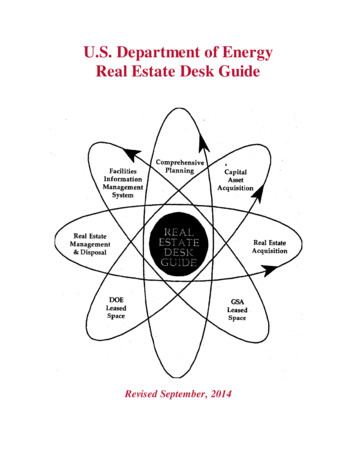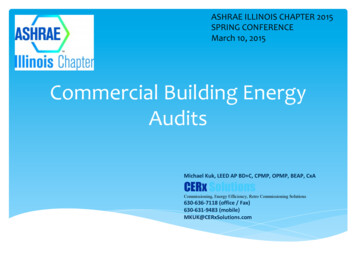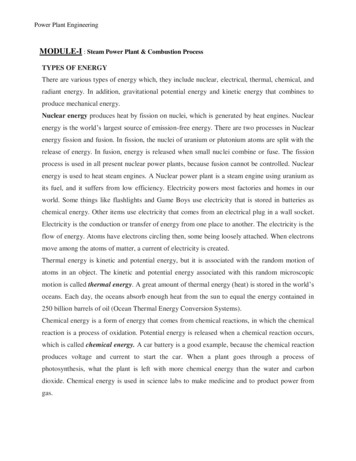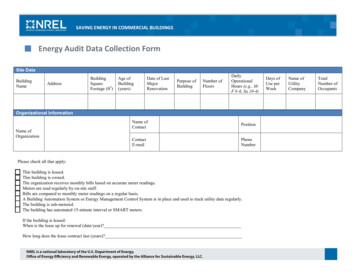
Transcription
U.S. Department of EnergyReal Estate Desk GuideRevised September, 2014
U. S. Department of Energy – Real Estate Desk GuideRevised 2014Real Estate Desk GuideTable of ContentsChapter 1-- Purpose of Desk Guide. 1Chapter 2-- Introduction . 3Chapter 3-- Planning Policy . 9Chapter 4-- Real Estate Function . 12Chapter 5-- Acquisition of Interests in Real Property. 16Chapter 6-- Acquisition by Lease. 36Chapter 7-- Land and Property Rights Management . 47Chapter 8-- Disposal of Real Estate . 55Chapter 9-- Facilities Information Management System (FIMS)/Records . 64Chapter 10-- Real Estate Certification Program. 68Appendix 1--Links to Referenced Documents . 69Appendix 2--Telecommunications Siting Procedures. 73Appendix 3--Funding Off-Site Public Road Work . 87Appendix 4--Table of Authorities. 90Appendix 5--Leasing-Related Statutes & Executive Orders . 91
U. S. Department of Energy – Real Estate Desk GuideRevised 2014Chapter 1: Purpose of the Desk GuidePURPOSEFederal agencies realize the importance of managing real property assets to attain optimumusage and maximal returns and benefits to the holding agency, the Government at large, and the public.Long-range planning is the key to determining which actions need to be taken with respect to acquiring,managing and/or disposing of real property. The aim of this Desk Guide is to provide perspective on theday-to-day activities of Department of Energy (DOE) Realty Specialists as they relate to overall realestate asset management. From this perspective, the Realty Specialist can determine where a particularaction lies within the overall real estate process, and perceive the relationship between the various realestate tasks, and their impact on future planning and management.The Desk Guide provides an overview of the essential functions in the real estate process,emphasizes proper real property asset management as an integral part of real estate decision-making,and provides reference to authorities governing specific real estate actions. Its structure reflects thenormal sequence of events in the real estate process: from planning, to acquisition, throughmanagement, and ultimately to disposal. Emphasis is placed on comprehensive land-use planning as aprincipal tool in effective real property asset management, and on the necessity of maintaining accuratereal estate data in the Facilities Information Management System (FIMS).APPLICABILITYThis Desk Guide is intended to be a resource for all DOE elements with responsibility forreal property, including the National Nuclear Security Administration (NNSA). Nothing in thisDesk Guide is intended to conflict with the provisions of the National Nuclear Security Act.RECOMMENDED USEThis Desk Guide is not intended as a prescriptive document outlining mandatory steps inthe real estate process. Rather, it should be viewed and used as a means of identifying authorities andgood practices relating to matters or problems encountered in real estate projects. Mandatoryauthorities are identified and summarized for convenience, but the Guide itself is not mandatory and therelevant authorities govern the actions discussed. Essentially, the Guide provides the “guiding path” byidentifying the central actions and procedures of the DOE real estate process.The Guide also serves as an educational tool by covering the entire real estate process. Itprovides Realty Specialists and others with a general familiarization of the process, and new personnelwith a concise description of the responsibilities and considerations they will face in managing realproperty assets. While the guide cannot address the numerous courses of action that might be pursuedby Realty Specialists in carrying out their duties, it should enable them to view possible actions in light ofthe standard procedures and steps which are outlined.STRUCTUREThe chapters in the Desk Guide are arranged to follow the normal sequence of events in the"cradle (planning/acquisition) to grave (management/disposal)” real estate process. Each chapter opensChapter 1: Purpose of the Desk GuidePage 1
U. S. Department of Energy – Real Estate Desk GuideRevised 2014with an explanation of the processes and procedures encompassed by the chapter title. Each chapterexplains the processes for the various types of actions within a given category. In addition, each chapteridentifies responsibilities and legal obligations, and indicates what forms and documents are generallyemployed in completing an activity.Referenced DocumentsWith the institution of DOE Order430.1B, Real Property Asset Management(RPAM) initiatives (see DOE Order s existing orders and directives addressing the various real estate operations werephased out. Much of the information, processes,and procedures contained in these orders anddirectives remain usable as a basis for developing courses of action. This is particularly true offormer DOE Order 4300.1C, Real PropertyManagement, and the United StatesChapter 1: Purpose of the Desk GuideDepartment of Energy Leasing Handbook(1990). They describe in useful detail theelements that should be considered in theexecution of real estate project tasks.Again, these are not policy directives,but tools to assist field office personnel andcontractors in performing their duties.Thus, while no longer mandatory forreal estate operations, these documents, as wellas others, provide useful information, guidanceand insight, and are referred to frequently in thisDesk Guide.Page 2
U. S. Department of Energy – Real Estate Desk GuideRevised 2014Chapter 2: IntroductionBASIS FOR THE DOE REAL ESTATE PROCESSThe generic legislation under which DOE has real property holding authority is the DOEOrganization Act (Public Law (PL) 95-91). Generally, departments and agencies with such authoritymay exercise the full range of real estate activities. Section 647 of the Act (42 United States Code(USC) 7257) specifically addresses the property holding responsibilities of DOE. Under this section,theSecretary of Energy is "authorized to acquire (by purchase, lease, condemnation, or otherwise),construct, improve, repair, operate, and maintain laboratories, research and testing sites and facilities,quarters, and related accommodations.” The Department, as successor to the Atomic EnergyCommission, has similar authority for real property that falls under the jurisdiction of the Atomic EnergyAct of 1954, as amended (PL 83-703, section 161g)(42 USC 2201(g)).In addition to these responsibilities, which are directly related to the accomplishment of DOE'stechnical missions, DOE may, subject to GSA approval on a case-by-case basis, acquire generalpurpose office and related space, less than 20,000 square feet in area, and certain special purposespace by virtue of delegated lease acquisition authority from the General Services Administration. DOEalso may authorize its contractors, through provisions in their contracts, to procure space needed inconnection with DOE programs and projects. These latter authorities stem from the Federal Propertyand Administrative Services Act of 1949 (40 USC 512) which permits GSA to delegate to other Federalagencies its authority to procure leased space. In exercising its delegated authority, DOE is subject tothe rules and requirements of the Federal Management Regulations (FMR part 102-72 and the GeneralServices Acquisition Regulation (GSAR) as incorporated into the General Services Acquisition Manual(GSAM).Within the parameters of the enabling legislation and the delegated authority, DOE hasestablished policies and procedures for the operation of its real estate function. The overall direction forthe Department of Energy's real estate program is contained in DOE Order 430.1B, Real PropertyAsset Management (RPAM), issued September 24, 2003. The order establishes a corporate, holistic,and performance-based approach to real property life-cycle asset management that links real propertyasset planning, programming, budgeting, and evaluation to program mission projections and performanceoutcomes. To accomplish the objective, this Order identifies requirements and establishes reportingmechanisms and responsibilities for real property asset management.DOE O 430.1B cancelled DOE O 4300.1C, Real Property Management, which containedrequirements and procedures for real estate actions. The 2004 version of this Desk Guide encouragedthe continued use of DOE O 4300.1C as a reference and included it in the Appendix. In the 2011 DeskGuide revision, much of the information found in DOE O 4300.1C was incorporated into chapters 5, 6,7and 8, with updated references to statutes, regulations, orders and DOE organizational elements. Onegoal of the 2011 revisions was to provide DOE Realty Specialists with more detailed guidance, as foundin DOE O 4300.1C, while reflecting the various changes that have taken place since DOE O 4300.1Cwas published in 1992. The full text of DOE O 4300.1C can be found in the Department of EnergyReal Estate Process at:http://fimsinfo.doe.gov/RE/Desk%20Guide/dg appendices.pdf. Note that the Department of EnergyChapter 2: IntroductionPage 3
U. S. Department of Energy – Real Estate Desk GuideRevised 2014Real Estate Process was the Appendix to the 2004 Desk Guide. In addition to DOE O 4300.1C, theReal Estate Process contains other reference material such as the Department of Energy LeasingHandbook and transactional forms. Much like DOE O 4300.1C, the other material in the Real EstateProcess is not necessarily current and is being maintained primarily as a historical reference. Somematerial, such as transactional forms, may be useful but should be reviewed for currency and accuracyprior to use.Other documents that are helpful in outlining the fundamental real estate processes are theDepartment of Energy Leasing Handbook , the Good Practice Guides on Site Selection (No. 024) andComprehensive Land-use Planning (No. 033). These documents provide an overall view of theessential matters that a Realty Specialist must address in performing his/her role. This Desk Guidebrings together documents addressing capital asset management, leasing procedures, out-grants, etc.,ina single, quickly accessible form. It broadens coverage of the real estate process by presenting thecommon steps Real Estate personnel will generally follow to complete either routine or complex realestate actions. A major goal of the Desk Guide is to identify the role of Real Estate in the planning andasset management areas of the process, and to focus on the necessity for close interaction betweenReal Estate and the other field elements with responsibility for meeting the RPAM requirements (seespecifically, Chapters 3, 4, and 9)To understand the roles of the offices involved in the real estate process, this Introductionincludes brief explanations of the functions of these offices as they relate to the management of realproperty assets. These explanations are meant to be short general overviews of each office's role in thereal estate process; they are not intended to describe all of the functions these offices perform.ROLE OF REALTY SPECIALISTThe Realty Specialists are responsible for managing the real estate program for their respectiveentities or organizations. They play the central role in the housing of DOE employees, whether throughdeveloping requirements for a GSA space acquisition, satisfying a property need themselves, oroverseeing and approving a contractor leased space acquisition. Realty Specialists are charged withimplementing the RPAM directive and other real estate/asset management policies, procedures, andinitiatives developed by Headquarters. They participate directly in land-use planning and are key playersin plan implementation. The major tasks they perform include: acquiring interests in real property;managing real estate inventory, including the out-granting of owned or leased property; identifyingexcess property and arranging for its disposition; and assuring that data covering real property assets ismaintained in the Facilities Information Management System.Certified Realty Specialists (CRS)Pursuant to RPAM and formal delegations of authority from NA-1 and MA-1, designatedCertified Realty Specialists (CRS) are authorized to review and approve realty actions commensuratewith the level of the designation, (except for acceptance of donations or the institution of condemnationactions).Real Estate Contracting Officers (RECO)In 2013, the Director, Office of Property Management (MA-65) was designated the Head ofContracting Activity (HCA) for real property management which includes the authority to issue RECOwarrants. Subsequently, all then-current CRS’s were appointed as RECOs. A RECO has the authorityto execute real estate agreements and instruments within limits prescribed in his or her certificate ofChapter 2: IntroductionPage 4
U. S. Department of Energy – Real Estate Desk GuideRevised 2014appointment. To be appointed as a RECO, a Realty Specialist must already possess a CRS designation,so the requirement in 430.1B for CRS review and approval is satisfied when a RECO executes anaction.Delegations of AuthorityThere are various delegations of authority to officials in Program and Site Offices that include realestate actions. An official holding such a designation may execute real estate agreements andinstruments within the scope of the delegation, but review and approval by a CRS is required.Alternatively, the RECO may execute the action instead of the official holding the delegation.The decision to pursue any particular real estate action is a management decision of the ProgramOffice. The role of the CRS is to ensure that applicable real estate laws, regulations and policies areobserved in the decision-making process and resulting agreement and/or instruments.Interaction of Real Estate and Field Planning ActivitiesThe development of a comprehensive land-use plan and a Ten Year Site Plan requires close, integratedaction between Real Estate and other key planning processes in the field, including NEPA, utilityplanning, asset management, and project planning. This interaction and joint plan formulation canfacilitate implementation of land-use decisions, and make Real Estate better able to determine thenecessary real property rights to be acquired to perform the mission, establish the appropriate spaceparameter requirements, assure the optimum usage of real property and space, and dispose of rights nolonger needed to support the mission. (See Chapter 3 on Comprehensive Planning and the Land-use Planning and Management Processes.)ROLE OF NNSA REALTY SPECIALISTSNNSA Realty Specialists manage real estate activities for all NNSA sites and facilities.Realty Specialists within NNSA function as a Headquarters unit at the Albuquerque Complex inAlbuquerque, New Mexico, and provide realty support to both the field elements and NNSA HQ.Wherever applicable, when “SRO” or “CRS” is referenced throughout this Desk Guide; the NNSARealty Specialist is the point-of-contact for all NNSA sites and facilities. Where a site or facility isunder the authority of both NNSA and non-NNSA DOE programs, the NNSA Realty Specialistshould manage real estate activities for NNSA-controlled property, but not for any non-NNSAproperty, which should be managed by an on-site CRS from the appropriate DOE Program Officeor the SRO.ROLE OF THE FIELD ELEMENTSThe DOE Field Elements are responsible for preparation of budget requests and planning forphysical assets, including real property. They have responsibility for identifying excess real property thathas significant remaining useful life. The field elements are charged with assuring that inactive andsurplus facilities are managed adequately until a reuse is found or the property is disposed of. They alsomust assure the establishment of an efficient, economic approach to asset management in conjunctionwith program offices and the Office of Acquisition and Project Management (MA-60). These elementsare accountable to the program offices and the Landlord program office for contractor performance,and coordinate all review and external oversight activities of the contractors.Chapter 2: IntroductionPage 5
U. S. Department of Energy – Real Estate Desk GuideRevised 2014ROLE OF HEADQUARTERSSecretary of Energy or DesigneeThe Secretary of Energy, or NA-1 for NNSA sites, authorizes the acquisition of interests in realestate by condemnation; accepts real property donations; and approves critical strategic planningdecisions. See Section 5 in RPAM for other rules and responsibilities.Office of Acquisition and Project ManagementOAPM serves as the point-of-contact for external activities and issues relating to real propertylife-cycle asset management. It provides technical assistance to program offices, landlord programs,and field elements. See Section 5a in RPAM for other rules and responsibilities.Program OfficeThe program office is responsible for defining, planning, and budgeting for program needs,including operations, facilities, and projects. It oversees field element program and projectimplementation, and field elements to assure an efficient, economic approach to asset management.See Section 5a in RPAM for other rules and responsibilities.Program Office Designated as LandlordThe Landlord program offices are responsible for establishing policies and procedures andfunding for the site's implementation of programs and projects relative to the management of siteinfrastructure. For multi-program sites, the Landlord coordinates funding requirements with otherprogram offices. The Landlord also reviews field element infrastructure activities in conjunction withthe program offices.Real EstateRealty Specialists in the Office of Acquisition and Project Management (OAPM) are theDOE's official point of contact in headquarters for real estate matters outside the Washington D.C.National Capitol Region (where GSA’s National Capital Region Office handles most federal officespace matters). OAPM’s Realty Specialists provide guidance and assistance to the field in the entirerange of real property activities including comprehensive land-use planning, acquisition (including condemnation and leasing), management (including outleasing), disposal, and data collection and reportingas part of the Facilities Information Management System (FIMS). In the event a site does not have aCRS, all actions are to be sent to the Senior Realty Officer (SRO) in OAPM for review and approval,per DOE O 430.1B.ROLE OF CONTRACTORSContractors or subcontractors, including Maintenance and Operations contractors, may beauthorized to perform real estate work for DOE, which may involve the acquisition, lease or disposal ofreal estate or interests therein, and reimbursement of the contractor for the cost. DOE RealtySpecialists review, and approve, contractor practices and transactions relating to the lease, acquisitionand management of real property to make sure that their actions are in accordance with the same laws,regulations, policies and standards as applicable to DOE for leasing, such as competition in contracting,fair market appraisals and other pertinent requirements, and that proper consideration is given toeconomy, efficiency, and programmatic need.Key Areas of Responsibility for Realty SpecialistsChapter 2: IntroductionPage 6
U. S. Department of Energy – Real Estate Desk GuideRevised 2014 FIMS corporate real estate database Acquisition of real estate Withdrawal from public domain Donation of real estate to DOE by others Condemnation of real estate Exchange of real estate CERCLA/RCRA real estate requirements Transfer of DOE real estate to Community Re-Use Organizations Sale of DOE real estate Transfers of real estate to other government agencies Disposal of DOE real estate through GSA Leasing of real estate owned by others Leasing DOE real estate to others GSA assigned space DOE’s Management and Operations Contractor’s Leasing Program Utilization of real estate Demolition of buildings Land Use Plan (see Chapter 3) Relinquishment of DOE withdrawn landChapter 2: IntroductionPage 7
U. S. Department of Energy – Real Estate Desk GuideRevised 2014Chapter 3: Planning PolicyAs covered in the DOE Order 430.1B (Real Property Asset Management), planning is theoverarching function within real property asset management that integrates the other functions ofacquisition, real property utilization, maintenance, recapitalization, disposition, and Long TermStewardship (LTS) into a coordinated effort to ensure that current and future mission needs are met.Planning is dependent on clear objectives, sound data, and effective communication between all partiesat a site.(1)Site planning for real property assets must be consistent with EO 13327 (Federal Real PropertyAsset Management) and should be based on guiding principles:GOVERNMENT ASSET MANAGEMENT PRINCIPLES1. USE WHAT YOU HAVE FIRSTReal property assets under the custody and control of the Federal Government should beconsidered first when accommodating Federal agency mission requirements.2. BUY ONLY WHAT YOU NEEDThe amount of interest in Federal real property assets should be the minimum necessary toeffectively support a Federal agency's mission.3. USE INDUSTRY-LIKE INSTRUMENTS OF AGREEMENTReal property assets of the Federal Government should be utilized among agencies with theuse of instruments of agreement that follow the best practices of the industry.4. REINVESTMENT IS ESSENTIALReinvestment in a real property asset is essential to maintain its fair market value, its ability tobenefit from advancements in business practices and technologies, and to support the Federalmission and enhance employee productivity.5. INCOME/EXPENSES COMPARABLE TO THE MARKETAny income realized by a real property asset during its useful life should approximate thatgenerated by a comparable commercial property; while any expense by such an asset duringits life cycle should approximate that incurred by a comparable commercial property.6. MAXIMIZE USE AMONG AGENCIESThe maximum utility of a real property asset can be realized if it is continuously transferredamong agencies having mission needs while it is under the control of the Federal Government.7. TIMELY DISPOSALA Federal real property asset that has no further mission supporting use by the FederalGovernment should be disposed of timely and in a manner that best serves the public interest.8. RETAIN PROCEEDS FROM DISPOSAL AND OUTLEASINGThe proceeds gained from the disposal of a Federal real property asset, or from outleasing,are not currently available for use by most Federal agencies having custody, control and useof the asset. Under the “Hall Amendment” (42 U.S.C. § 7256(c)), services in kind orChapter 3: Planning PolicyPage 9
U. S. Department of Energy – Real Estate Desk GuideRevised 2014retention of cash are the only forms of receipts currently available to DOE.9. PROFESSIONAL TRAININGFederal employees should be given the training needed to perform their jobs at the highestlevel of professionalism, and in order to utilize models and other analytical tools for optimizingtheir real property asset management decisions consistent with the provisions of ExecutiveOrder 12931(Federal Procurement Reform).(2)For each non-closure site, results of real property asset site planning and performance must bedocumented in a Ten-Year Site Plan (TYSP) that is kept current and covers a 10-year planninghorizon. For closure sites, disposition plans must be developed.(a) The TYSP will be consistent with and support development of the Integrated Facilities andInfrastructure (IFI) Crosscut Budget, identifying the resource requirements associated withTYSP implementation. (Figure 1 represents the relationship between the TYSP and IFI CrosscutBudget.)(b) The TYSP will be integral to and support the DOE Planning, Programming, Budgeting, andEvaluation System (PPBES).(c) The TYSP will result in a consolidated and integrated plan replacing multiple reports. It willuse the Facilities Information Management System (FIMS), DOE's corporate real property assetdatabase, for real property asset information.(3)The content of the TYSP addresses how the site's real property assets support the Department'sstrategic plan, the Secretary's 5-year planning guidance, and appropriate program guidance. As acomprehensive site-wide plan encompassing the needs of tenant activities, the format of theTYSP should be consistent within a program in accordance with program direction and guidance.Sections of the TYSP can be rearranged to meet the unique requirements of a site. As aminimum, TYSPs address the following.(a) The site's plan to meet program missions, budgets, planning estimates, and performanceoutcomes within the program's budgetary and out-year fiscal projections.(b) An assessment of the current status of the site real property assets against delineatedprogram missions including discussions of condition assessments, maintenance and recapitalizationplans, space utilization, real estate, excess facilities disposition, LTS, and unique site issues.(c) The prioritized real property asset projects and activities required to meet program missions,budgets, and planning estimates. These include acquisition projects, elimination of excessproperty projects and activities, maintenance and recapitalization plans, disposition projects, andLTS requirements.(d) The prior year (PY) plus ten (10) additional fiscal years of activities, planned in accordancewith Lead Program Secretarial Office (LPSO), Cognizant Secretarial Office (CSO), andProgram Secretarial Office (PSO) annual program direction and guidance for mission projectionsand fiscal projections. It will be consistent with the Department's PPBES and the field budgetcall.Chapter 3: Planning PolicyPage 10
U. S. Department of Energy – Real Estate Desk GuideRevised 2014(e) A report on past performance and projected future outcomes, including the results from realproperty asset corporate and program performance measures (see paragraph 4g of DOE O430.1B (RPAM) for corporate performance goals and measures). The report must compare thebudget authority against the actual expenditures and the performance outcomes achieved at thesite for the fiscal year that precedes the PY.(f) Space utilization activities and land-use that stabilize then reduce the costs by consolidatingoperations where practicable and eliminating excess facilities.(4)The TYSP is submitted either concurrently with responses to the field budget call, or as directedby the LPSOs/CSOs/PSOs to be consistent with the PPBES cycle.Ten Year Site PlanNew Mission Line Item Capital Projects (as governed by DOE O 413.3)Integrated Facilities & Infrastructure CrosscutFacilities & Infrastructure Line Item Projects(General Plant type projects 5M)GPP & Institutional GPPRepair WorkMaintenance WorkExcess EliminationDisposition Plans030405PYCYBYPY Prior YearCY Current YearBY Budget Year060708PPBES0910111213The TYSP and the IFICrosscut Budget must beconsistent with each other.Figure 1. Ten-Year Site Plan (TYSP);Integrated Facilities and Infrastructure (IFI) CrosscutBudget; and Planning, Programming, Budgeting, andEvaluation System (PPBES)Chapter 3: Planning PolicyPage 11
U. S. Department of Energy – Real Estate Desk GuideRevised 2014Chapter 4: Real Estate FunctionThe Real Property Asset Management (RPAM) Order (DOE O 430.1B) directs that an integrated,systematic approach be used in managing the real estate function of DOE.The real estate function encompasses several key activities over the life cycle of real property assets.These activities involve acquisition by lease or purchase; planning and management, including takinginventory, making assignments, conducting utilization surveys, and tracking assets; screening for excessreal property assets; and disposal of real property assets.(1)The Secretary's authority to acquire, manage, and dispose of real property can be re-delegated,with the exception of accepting donations, initiating condemnation actions or executingdeclarations of takings. In exercising the delegated authority, all real estate actions to acquire,manage, and dispose of real property assets are to be reviewed and approved by a DOE CRSbefore executing the action. The SRO in OAPM will provide the review and approval for thosesite offices without a CRS.(2)A CRS must be involved in planning, acquisitions, utilization surveys, excess declarations,disposal by demolition or sale of real property assets. These actions are performed inaccordance with the requirements in 41 CFR, Chapter 102, Federal Management Regulationand DOE real property authorities. The DOE Real Estate Process-Desk Guide for RealEstate Personnel provides detailed guidance and procedures for completing real estate actions.These actions will be reflected in the Ten Year Site Plans (TYSP).(3)Land-use planning and management integrates land uses at each site and examines multipleland-
Feb 04, 2004 · Real Estate Process was the Appendix to the 2004 Desk Guide. In addition to DOE O 4300.1C, the Real Estate Process contains other reference material such as the Department of Energy Leasing Handbook and transactional forms. Much like DOE O 4300.1











